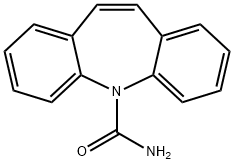298-46-4

Product Name:
Carbamazepine
Formula:
C15H12N2O
Synonyms:
5H-Dibenz[b,f]azepine-5-carboxamide
Inquiry
CHEMICAL AND PHYSICAL PROPERTIES
| Physical Description | Solid |
|---|---|
| Color/Form | Crystals from absolute ethanol and benzene |
| Boiling Point | 399.6±45.0 |
| Melting Point | 189-192 |
| Solubility | >35.4 [ug/mL] (The mean of the results at pH 7.4) |
| LogP | 2.77 |
| LogS | -3.2 |
| Stability/Shelf Life | To study the photostability of carbamazepine polymorphs, the pure materials on the tablet surface were evaluated without physical damage by means of Fourier-transform infrared reflection-absorption infrared spectrometry (FT-IR-RAS) and colorimetric measurement of the carbamazepine polymorphs I, II, and III, after photodegradation at 2 irradiation intensities under a near-UV fluorescent lamp. The surface of sample pellets of all crystalline forms turned gradually from white to yellow-orange upon exposure to light, and the discoloration rate of form II was faster than that of forms I and III, indicating that form II was the most unstable of the three. The semilogarithmic plots of the photodegradation profiles of the various polymorphs were straight lines, including the induction period, indicating that degradation of the drug on the surface followed first-order kinetics. The induction periods of all forms were not significantly different. However, the degradation rate constant of form II was 5.1 and 1.5 times larger than those of forms I and III, respectively. |
| Ionization Efficiency | Positive |
| Dissociation Constants | 15.96, -3.8 |
| Collision Cross Section | 150.3 Ų [M+H]+ [CCS Type: TW, Method: Major Mix IMS/Tof Calibration Kit (Waters)] |
| Kovats Retention Index | 2296 2259 2259 2290 2285 2310 2337 2340 2280.2 2316.8 2275 2270 2290 2310 2290 |
| Other Experimental Properties | STABLE TO HYDROLYSIS |
SAFETY INFORMATION
| Signal word | Danger |
|---|---|
| Pictogram(s) |
 Exclamation Mark Irritant GHS07  Health Hazard GHS08 |
| GHS Hazard Statements |
H302:Acute toxicity,oral H317:Sensitisation, Skin H336:Specific target organ toxicity,single exposure; Narcotic effects |
| Precautionary Statement Codes |
P201:Obtain special instructions before use. P280:Wear protective gloves/protective clothing/eye protection/face protection. P302+P352:IF ON SKIN: wash with plenty of soap and water. P308+P313:IF exposed or concerned: Get medical advice/attention. |
COMPUTED DESCRIPTORS
| Molecular Weight | 236.27 g/mol |
|---|---|
| XLogP3 | 2.5 |
| Hydrogen Bond Donor Count | 1 |
| Hydrogen Bond Acceptor Count | 1 |
| Rotatable Bond Count | 0 |
| Exact Mass | 236.094963011 g/mol |
| Monoisotopic Mass | 236.094963011 g/mol |
| Topological Polar Surface Area | 46.3 Ų |
| Heavy Atom Count | 18 |
| Formal Charge | 0 |
| Complexity | 326 |
| Isotope Atom Count | 0 |
| Defined Atom Stereocenter Count | 0 |
| Undefined Atom Stereocenter Count | 0 |
| Defined Bond Stereocenter Count | 0 |
| Undefined Bond Stereocenter Count | 0 |
| Covalently-Bonded Unit Count | 1 |
| Compound Is Canonicalized | Yes |
PRODUCT INTRODUCTION
description
Carbamazepine is a dibenzoazepine that is 5H-dibenzo[b,f]azepine carrying a carbamoyl substituent at the azepine nitrogen, used as an anticonvulsant. It has a role as an anticonvulsant, an EC 3.5.1.98 (histone deacetylase) inhibitor, a mitogen, a glutamate transporter activator, an antimanic drug, an analgesic, a non-narcotic analgesic, an environmental contaminant, a xenobiotic, a drug allergen and a sodium channel blocker. It is a dibenzoazepine and a member of ureas.
